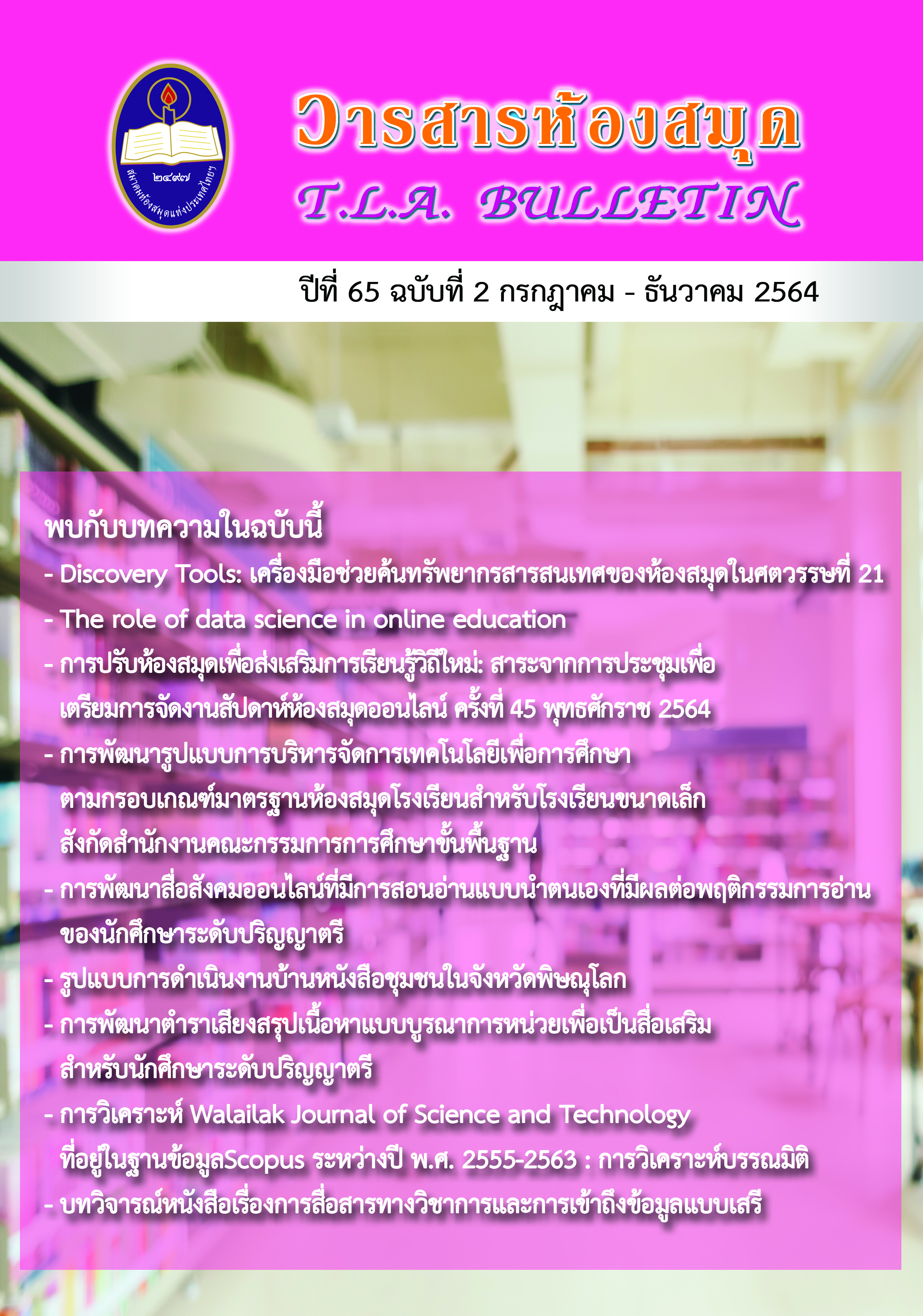Discovery Tools: เครื่องมือช่วยค้นทรัพยากรสารสนเทศของห้องสมุดในศตวรรษที่ 21
คำสำคัญ:
เครื่องมือช่วยค้น, ส่วนต่อประสานเดียว, การสืบค้นสารสนเทศบทคัดย่อ
เครื่องมือช่วยค้นนับเป็นส่วนหนึ่งที่สนับสนุนการจัดบริการของห้องสมุด มีจุดมุ่งหมายเพื่อให้ผู้ใช้สามารถค้นหาและเข้าถึงสารสนเทศที่ตรงความต้องการและได้รับสารสนเทศที่มีความน่าเชื่อถือ โดยเป็นเครื่องมือที่จัดทำดรรชนีช่วยค้นและสามารถกลั่นกรองผลการค้นจากทรัพยากรสารสนเทศของห้องสมุดที่มีรูปแบบหลากหลายได้อย่างมีประสิทธิภาพเช่นเดียวกับการสืบค้นกูเกิล บทความนี้นำเสนอเนื้อหาเกี่ยวกับ Discovery tools ในประเด็นความเป็นมา ความหมาย ประเภท คุณลักษณะ การเปรียบเทียบ และตัวอย่างการสืบค้น Discovery tools ซึ่งจะเป็นทางเลือกสำหรับบรรณารักษ์และนักเอกสารสนเทศในการปรับปรุงเครื่องมือช่วยค้น โดยพิจารณา Discovery tools เป็นทางเลือกหนึ่งเพื่อสนับสนุนการค้นหาและเข้าถึงสารสนเทศที่มีให้บริการในห้องสมุดได้อย่างคุ้มค่ามากที่สุด
Downloads
เอกสารอ้างอิง
Asher, A. D., Duke, L. M., & Wilson, S. (2013). Paths of discovery: Comparing the search
effectiveness of EBSCO Discovery Service, Sommon, Google Scholar, and conventional
library resources. College & Research Libraries, 74(5), 464-488.
Breeding, M. (2015). The future of library resource discovery. Retrieved May 7, 2021, from
https://groups.niso.org/apps/group_public/download.php/14487/future_library_resource_discovery.pdf
Chickering, F. W., & Yang, S. Q. (2014). Evaluation and comparison of discovery tools: An update.
Information Technology and Libraries, 33(2), 5-30.
Dalal, H. A., Kimura, A. K., & Hofmann, M. A. (2015). Searching in the wild: Observing
Information seeking behavior in a discovery tool. Retrieved May 7, 2021, from
Donlan, R., & Cooke, R. (2005). Running with the Devil: Accessing library-licensed full text
holdings through Google Scholar. Internet Reference Services Quarterly, 10(3-4),
-157.
Fagan, J. C., Mandernach, M., Nelson, C. S., Paulo, J. R., & Saunders, G. (2012). Usability test
results for a discovery tool in an academic library. Information Technology and Libraries,
(1), 83-112.
Fawley, N. E., & Krysak, N. (2012). Information literacy opportunities within the discovery tool
environment. College & Undergraduate Libraries, 19(2-4), 207-214.
Goodsett, M. (2014). Discovery search tools: A comparative study. Reference Reviews, 28(6), 2-8.
Herrera, G. (2011). Google Scholar users and user behaviors: An exploratory study.
College & Research Libraries, 72(4), 316-331.
Hoseth, A. (2011). Google Scholar. The Charleston Advisor, 12(3), 36-39.
Imler, B., & Eichelberger, M. (2011). Do they “get it”? Student usage of SFX citation linking
software. College & Research Libraries, 72(5), 454-463.
Korah, A., & Cassidy, E. D. (2010). Students and federated searching. Reference & User Services
Quarterly, 49(4), 325-332.
Luther, J. (2003). Trumping Google? Metasearching’s promise. Library Journal, 128(16), 36-39.
Vaughan, J. (2011a). Chapter 1: Web scale discovery: What and Why? Library Technology
Reports, 1, 5-11.
Vaughan, J. (2011b). Chapter 6: Differentiators and a final note. Library Technology Reports, 1,
-53.
Way, D. (2010). The impact of web-scale discovery on the use of a library collection. Serials
Review, 36(4), 214-220.
Wisniewski, J. (2010). Web scale discovery: The future’s so bright, I gotta wear shades. Online,
(4), 55-57.
Yang, S. Q, & Wagner, K. (2010). Evaluating and comparing discovery tools: How close are we
towards next generation catalog? Library Hi Tech, 28(4), 690-709.




